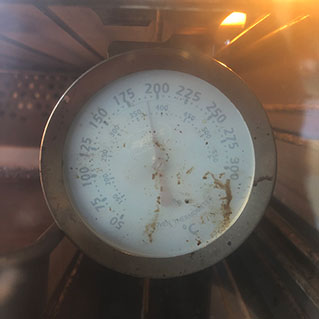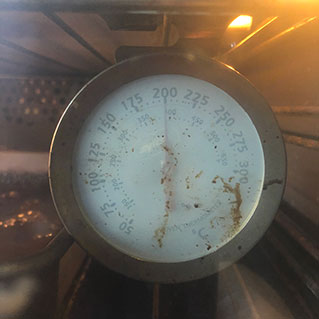Unfortunately, it is common to hear a home baker puzzling about a loaf with a dense layer across the lower crust, and a huge ‘bubble’ or a ‘flying’ upper crust.
The reason for the defect in the loaf is simple but generally misunderstood: the bread is under-baked.
How we get an under-baked loaf when we follow all the guidance of a recipe or formula is difficult for the baker to work out: the oven was pre-heated to the required temperature, the dough was loaded into the oven and the temperature was dialled back, all according to the instructions. So, why didn’t the bread bake properly?
First, let’s think about pre-heating the oven. Dialling up the correct temperature for pre-heating the oven seems like the right thing to do, but why do we do it? Pre-heating the oven is done to ensure there is enough heat in the structure of the oven (including an oven stone if it is being used) to start the process of heating the dough that will lead to baking the dough. Pre-heat temperature is usually 10 or 20 degrees higher than the baking temperature. The oven is ‘overheated’ to allow for heat losses when the oven is opened to load the dough. Each time the oven is opened, heat is lost immediately. When the dough is loaded into the oven, cooler objects are placed into the oven, so the heat in the oven drops again. The dough and any baking sheet or bread pan are around 180degC cooler than the oven. If the oven is pre-heated to, say, 210degC, the temperature may drop to around 170degC. For the dough to bake in the time allowed in the recipe or formula, the oven needs to re-gain the heat that was lost. The larger the mass of dough, the larger the heat loss due to the dough temperature. In my domestic oven, three demi-baguettes on a baguette tray, even with a pizza stone that has been in the oven, the oven temperature drops around 30degC. It takes around 10 minutes for the oven to return to the desired temperature if I keep the dial at 210degC. If I dial the temperature down to 200degC (the specified bake temperature), it will take much longer for the oven to return to the desired bake temperature. This delay in returning to the correct baking temperature will result in the dough being under-baked. The longer the delay, the more ‘under-baked’ the loaf.

heat lost when the door is opened to load dough 
oven heat recovered to desired temperature
To overcome this issue, I keep an inexpensive, portable oven thermometer in the oven so I can check the actual temperature in the oven. I keep the oven dialled to preheat temperature until the portable thermometer shows the oven to be at the desired temperature. Then I reduce the oven temperature setting to the desired baking temperature.
Another approach is to pre-heat at a higher temperature so that the heat loss will only reduce the oven temperature to the desired baking temperature.